
The buff ermine is a moth of the family Erebidae. It is sometimes placed in the genus Spilosoma. The species was first described by Johann Siegfried Hufnagel in 1766. It is found throughout the temperate belt of the Palearctic region south to northern Turkey, Georgia, Kazakhstan, southern Siberia, eastern Mongolia, Amur Region, China, Korea and Japan.

The agreeable tiger moth is one of three species of white tiger moth which are common in the United States. It has pronounced black eyes, white abdomen, and orange "bib" which set it apart from its cousin the Virginia tiger moth. Like its cousin, it tents its wings when as at rest.

Ardices curvata, the crimson tiger moth, is a moth of the family Erebidae. It was first described by Edward Donovan in 1805 and it is found in Australia. The species was formerly included in Spilosoma, but later generic status of Ardices was proved by Vladimir Viktorovitch Dubatolov (2005).
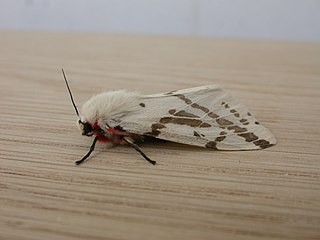
Ardices canescens, the dark-spotted tiger moth or light ermine moth, is a moth in the family Erebidae that is found across most of Australia. It originally was included in the genus Spilosoma, but later the generic status of Ardices was proven.

Spilosoma is a genus of moths in the family Erebidae originally described by John Curtis in 1825. A very heterogeneous group, it is in need of review by the scientific community, as certain species probably need reclassification into their own genera.
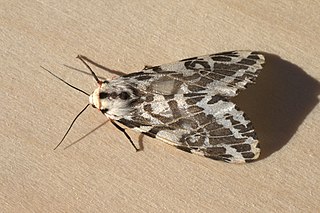
Ardices glatignyi, the black and white tiger moth, is a moth in the family Erebidae that is found in Australia. The species was first described by Le Guillou in 1841. Formerly included in Spilosoma, but later generic status of Ardices was proved by Vladimir Viktorovitch Dubatolov (2005). The larvae are polyphagous, and are known to feed on Lantana camara, Acanthus mollis, and Tradescantia albiflora.

Spilosoma obliqua, the jute hairy caterpillar or Bihar hairy caterpillar, is a moth of the family Erebidae. It is found in south-eastern Afghanistan, northern Pakistan, India, Bhutan, Bangladesh and Myanmar.

Spilosoma curvilinea is a species of moth of the family Erebidae. It was described by Francis Walker in 1855. It is found in Cameroon, Republic of the Congo, Democratic Republic of the Congo, Ghana, Ivory Coast, Kenya, Nigeria, Senegal, Sierra Leone, Sudan, Tanzania, the Gambia and Uganda.

Lacydes spectabilis is a moth of the family Erebidae. It was described by August Michael Tauscher in 1806. It is found in south-eastern Ukraine, eastern European Russia, western Siberia, Kazakhstan, Central Asia, Armenia, eastern Turkey, Turkmenistan, Afghanistan, China (Xinjiang) and southern Mongolia.

Spilosoma karschi is a moth in the family Erebidae. It was described by Max Bartel in 1903. It is found in the Democratic Republic of the Congo, Ghana, Guinea-Bissau, Malawi, Nigeria, Togo and Uganda.
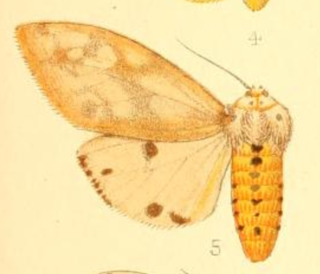
Spilosoma rava is a moth in the family Erebidae. It was described by Herbert Druce in 1898. It is found in Cameroon, the Democratic Republic of the Congo, Equatorial Guinea, Gabon, Ghana, Kenya, Liberia, Nigeria, Senegal, the Gambia and Uganda.
Spilosoma dubia, the dubious tiger moth, is a moth in the family Erebidae. It was described by Francis Walker in 1855. It is found from south-eastern Canada west to Alberta and in the eastern United States. The habitat consists of aspen parkland and southern boreal forests.
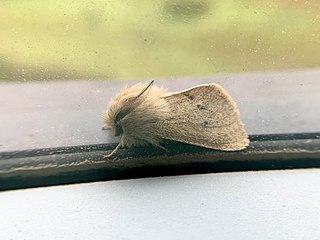
Spilosoma vagans, the wandering diacrisia or wandering tiger moth, is a moth in the family Erebidae. It was described by Jean Baptiste Boisduval in 1852. It is found in western North America, from southern California, southern Utah and central Colorado north to southern British Columbia and south-western Alberta. The habitat consists of drier forests, including open ponderosa pine forests and mixed hardwood-conifer forests.
Spilarctia inexpectata is a moth in the family Erebidae. It was described by Walter Rothschild in 1933. It is found in New Ireland in Papua New Guinea.
Spilarctia reticulata is a moth in the family Erebidae. It was described by Walter Rothschild in 1933. It is found in New Britain.
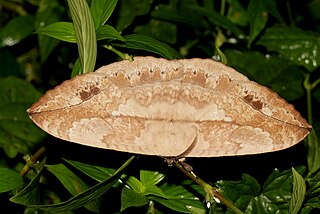
Eupterote is a genus of moths in the family Eupterotidae. It was first described by Jacob Hübner in 1820.













